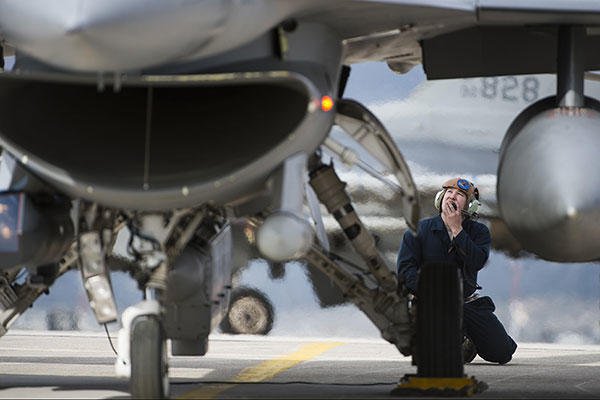SOUDA BAY, Greece — Let's face it, things break. A kid's toy, TVs, kitchen wear, automobiles, and yes, even a couple million-dollar airplanes can break. That's when the maintainers of the 52nd Fighter Wing get called to fix what's broken.
More than 15 F-16 Fighting Falcons assigned to the 480th Fighter Squadron at Spangdahlem Air Base, Germany, are on a forward training deployment at Souda Bay, Greece, for bilateral training with the Hellenic Air Force until Feb. 15.
"What we're here for is to get our pilots and maintainers trained and prepared for any future deployments that could send them downrange," said Capt. Erik Ringstad, the 480th Expeditionary Fighter Squadron Aircraft Maintenance Unit officer in charge. "My role here is to supervise and coordinate the maintainers we have, approximately 230 to provide safe, reliable and secure aircraft for our pilots."
Once an aircraft lands and is handed over to the maintainers, it can take up to three hours to turn around the aircraft and ready it for the next pilot.
Hellenic Air Force maintainers have been working with the 52nd FW maintainers to get a better understanding of hot pit operations, Ringstand added.
"They currently don't run that operation here, which is essentially refueling the aircraft while the engine is still running to expedite turn on the aircraft," he said. "They have been working with our guys to actually get an understanding and to eventually apply that here."
The U.S. Air Force's forward presence in Europe allows the U.S. to work with allies and partners to develop and improve ready air forces capable of maintaining regional security.
With flying times starting in the morning and into the late afternoon, it takes more than one shift of Airmen to maintain the aircraft.
"Right now we're on 10-hour shifts with the ability to go to 12-hour shifts if needed," said Chief Master Sgt. Brian Parsons, the 480th EFS AMU superintendent. "It's an open ramp environment which is good for the maintenance aspect of it, as long as the weather cooperates. When it rains, there is not a lot of cover out there."
For maintainers to get out in an expeditionary environment like this and see what kind of challenges they can face is good training, Parsons said. This deployment also shows continuing contributions to develop and improve air readiness while maintaining security and building long-lasting alliance capacity.
"My mission makes me feel proud and important," said Staff Sgt. Thai MacLeod, a 480th EFS AMU aerospace ground equipment craftsman. "If we don't provide power to the jets, the maintainers can't fix the jets, and jets can't fly. We play a pretty big part, and I like that."
They may not be fixing TVs or kids' toys, but the maintainers spend countless hours each day doing what they say they do best: fixing and maintaining the aircraft of the 52nd FW.
"At the end of the day, from a maintainer's perspective, we make sure we are proficient and give the aircrew reliable aircraft," Ringstand said.




























